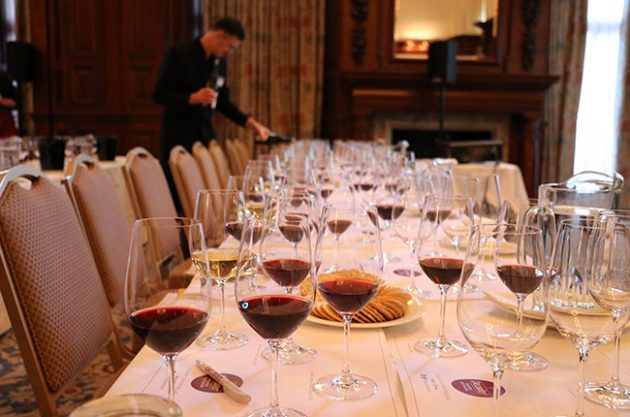
Jefford on Monday: The good and the right
Andrew Jefford considers the significance of comfort zones in wine appreciation.
It was, to my surprise, a faux pas. Our first summer in the Languedoc, and I served one of my precious bottles of aged Mosel Kabinett to local friends: perfect refreshment, or so it seemed to me. They glanced suspiciously at the golden white, sniffed, sipped – and were lost for words. Uncomplimentary words, evidently; I appeared to be forcing diluted cough mixture on them. The glasses, half-drained, were eventually laid wordlessly aside. My initiative was a total flop; the Mosel Kabinett had proved incomprehensible.
Since then, I’ve learned my lesson; Languedoc friends want to drink Languedoc wines. Even Burgundy and Bordeaux can prove a challenge. Wine from the other end of Languedoc is already an adventurous choice; most prized are the top cuvées from wineries within a 30-km radius of where we live.
I remembered something of the same thing during our sojourn in Adelaide, too. Not, of course, with wine-trade friends, who were limitlessly curious about the strange and the distant; but it was bottles from nearby Barossa which tended to make the parents of our children’s friends happiest. The latest Pinot from Gippsland or the Mornington Peninsula, by contrast, tasted dodgy to them, no matter how hard they (and the wines) tried.

Credit: Wikipedia
All of these drinkers have a clear sense of ‘what tastes right’. The notions of good, better or best are also significant, but ‘what tastes right’ comes first. Indeed it’s impossible for most drinkers to arrive at the notion of good, better and best in strange styles which don’t taste right. This is what performance managers call the comfort zone, and it’s more important in the wine world than serial experimenters (in other words, those who write and read wine columns) ever allow.
Take any wine journey, and you’ll find locals feel happiest with local wines; indeed the primary market for almost every wine region is the local market. Some wines never get beyond a local market – either because their production volumes are too tiny, or because their aesthetic call on the wider wine market is not strong enough. Italy, where villages without vineyards barely exist, has many wines of this sort. They may have a DOC, but their cultural interest outweighs any commercial interest they might have.
This makes wine consumers in non-wine-producing regions powerful: they are the ones who can decide which wines truly merit a wider market, and which are condemned to stay home.
Even drinkers who have never set eyes on a vineyard, of course, tend to be more contentedly familiar with some wines than with others. When I first discovered wine in the UK around 40 years ago, it was the light reds (as they were back then) of Bordeaux, Chianti and Rioja that tended to taste ‘right’ to most British drinkers, with the Loire and Germany providing the white and pink wine, much of it sweet. Sherry was the standard aperitif; port was what you drunk at Christmas.
Most UK drinkers now build their wine palates on inexpensive Australian and Californian wines, so the notion of what is ‘right’ in that market has comprehensively changed. Despite (or perhaps because of) the colossal choice on offer, many consumers stick with what is more or less familiar: that, indeed, is the core of brand appeal in wine, whether you define a brand in the customary commercial sense (Jacob’s Creek or Gallo) or whether you extend that notion to a wine with some sort of origin attached (Aussie Shiraz or Californian Chardonnay).
When serial experimenters sit down to share bottles with those who take no particular interest in wine beyond the recognition that it tastes nice and makes you smile, it’s often most surprising to discover the vehemence of dislikes rather than likes. Since wine is intimately linked with pleasure and relaxation, few relish being dragged against their will into the ‘optimal performance zone’ which surrounds the comfort zone, and still less into the danger zone beyond.
If we allow that ‘the right’ in wine often trumps ‘the good’, what are the implications of that?
The first is that any exporting region must, if it is to be successful, seem ‘right’ to the largest possible number of global consumers, so national generic promotions and the establishment of national brands (like ‘Brand Australia’ and its successor, ‘Australia Unlimited’) are sage. Allowing or encouraging every small region to promote itself without any kind of national framework, by contrast, is disastrous. European wine-promotion organisations constantly waste resources with clashing regional campaigns which never attain visibility but merely compete pointlessly with each other. A well-resourced, enduring, consistent national campaign running over a decade or more would be far more effective.
There are other things that Europeans do well, though. A vital part of ‘tasting right’ is based on drinkability, epitomised by the classic wine virtues of harmony, subtlety, well-judged ripeness, gastronomic aptitude (including some kind of tannic presence in the case of red wines) and a lack of modishness or violence of flavour. When the wines in a comfort zone have these kind of qualities, it is hard to dislodge them, since drinkers rarely grow out of or abandon this kind of flavour profile.
In my view, the unfair advantage held by red Bordeaux lies here: well-made wines from this region have such qualities to a greater and more successful extent than the wines of any other region. Consumers might be dissuaded from Bordeaux by the daunting prices of its finest wines and by the image difficulties (haughtiness, arrogance) which result from that, but its ‘rightness potential’ is almost unlimited. This is echoed, for white wines, by Burgundy, Chablis and the Mâconnais; and by Provence rosé, too. You don’t need to pay a lot to find that drinkability.
The most telling lesson of all, though, I barely need to repeat to those who might be reading this column. It is that there is an immense amount of personal pleasure to be had, over an entire lifetime and in most cases with commensurate health benefits, by expanding one’s wine comfort zone outwards into the optimal performance zone and sometimes even (natural wines? orange wines?) into the danger zone beyond.
Getting out of the comfort zone, once you are ready to do so, is like being given an entire garden to play in after years of making do with a couple of window boxes on a balcony. Suddenly you realise how subtle, intricate and diverse the wine world is, and in this how it reflects the larger world beyond, both in terms of its diverse physical landscapes and its cultural ones, too. Coming to appreciate wine’s diversity and richness implies, moreover, an expansion of your own perceptive faculties; in that sense, acquiring wine-knowledge is mind-expanding. You only have to want to do it; you only need go as far as you want. Serial experiment is not obligatory.
That’s why I’d suggest that one of the biggest growth areas in the wine world over the next few decades will be in wine education, to the extent that those who are looking for a career in wine would do well to think of this as much as of production and sales. This is especially true given that much of this expansion will come in Asia, where formal educational attainments are often accorded a higher value than elsewhere.
Can, though, ‘what is good’ eclipse ‘what is right’? I don’t think so, not even for the most devoted serial experimentalist. It’s not possible to unpick subjectivity; nor is it desirable. We all start from somewhere; we all have a tasting compass; and most of us eventually head back towards our port of departure. What matters is that the journey should be a rewarding one.
